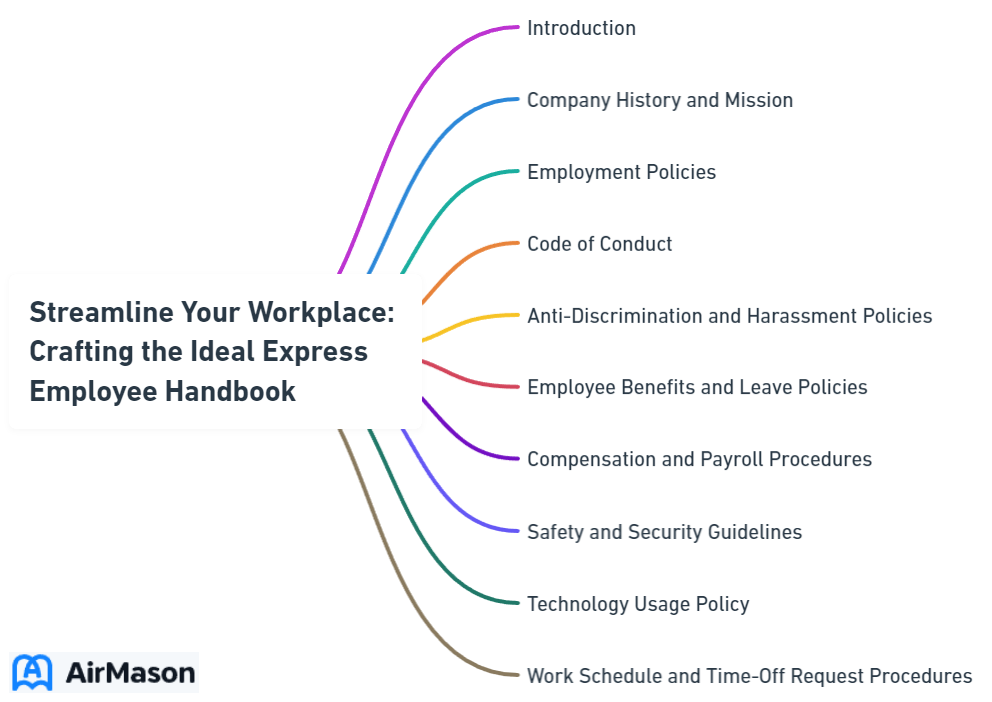
Creating an Express Employee Handbook? Learn the key elements to make it concise, current, and compelling. This guide ensures your handbook covers the essentials: core values, policies, benefits, and adherence strategies, tailored accurately for your team’s needs. Get started with our focused advice to streamline your employee onboarding and reference processes.
Key Takeaways
- Creating an effective employee handbook is essential and should include clear company values, straightforward policies, and detailed employee benefits to guide and engage employees.
- Handbooks should be digitally distributed and user-friendly, with interactive features and searchability to ensure easy access and understanding of company policies and procedures.
- Maintaining transparency in financial and contractual processes and safeguarding data privacy are critical to fostering trust, while receipt and acknowledgment tracking ensures all employees are informed and compliant with the handbook.
Employee Handbook Ethics
Employee Handbook Ethics are crucial for establishing a framework of moral conduct within an organization. These guidelines delineate the expected standards of behavior, integrity, and professionalism that all employees are required to adhere to. By clearly outlining ethical expectations, the employee handbook serves as a reference point for decision-making and promotes a culture of accountability. Additionally, it helps to mitigate potential conflicts of interest and unethical behavior by providing clarity on acceptable and unacceptable actions. Regular updates and communication regarding ethical guidelines ensure that employees remain informed and aligned with the organization’s values, fostering a positive work environment conducive to trust and integrity.
Mastering the Express Employee Handbook Creation

Crafting an effective employee handbook is no walk in the park. It requires precision, relevance, and a dash of creativity. The cornerstone of a complete employee handbook lies in defining your company’s core values, outlining essential policies, and detailing enticing employee benefits.
With these elements, you are all set to create a handbook that resonates with every new employee and serves as a reliable point of reference for all.
Defining Your Company’s Core Values
Core values are the heartbeat of your company. They are the fundamental principles that drive company actions, shaping behaviors, and influencing decisions for new employees. The process of defining these values should involve crafting a statement that encapsulates the essence of what your brand stands for, ensuring clear communication of the company’s values.
Creating such a statement allows your company’s values to form a solid foundation for the rest of your employee handbook.

Outlining Essential Company Policies
Company policies are the rulebook that guides employees through the ins and outs of your organization. The key to effectively delineating these policies in the handbook lies in clarity and simplicity. Clear, concise language allows employees to find necessary information swiftly, facilitating a smoother onboarding process and consistent adherence to the company’s rules and guidelines.
Detailing Employee Benefits and Perks
Let’s face it, who wouldn’t want to work in a place that recognizes and rewards their efforts? Providing a comprehensive overview of employee benefits and perks in your handbook not only attracts talent but also plays a significant role in employee retention.
Detailing benefits like health insurance, retirement plans, and flexible work arrangements caters to employees’ needs, fostering involvement which leads to improved productivity and morale. By maintaining accurate employee information, companies can ultimately benefit customers as well.
Streamlining Access and Usage for Employees

An employee handbook that is difficult to access and navigate can be as good as non-existent. The key to making your handbook user-friendly lies in digital distribution and interactive features. With the rapid advancement of technology, going digital is no longer an option but a necessity.
Leveraging online platforms and tools makes your handbook readily accessible, allowing employees to tap into its wealth of information whenever required.
Digital Distribution and Updates
In the digital age, distributing your employee handbook via traditional methods can seem outdated and inefficient. With digital distribution, not only do you save on printing costs, but you also ensure that your employees can access the handbook anytime, anywhere.
Furthermore, digital handbooks are easier to update, keeping all employees in sync with the latest policies and procedures.
Interactive Features and Searchability
A picture is worth a thousand words, and in the case of your employee handbook, interactive features like videos, GIFs, and images can make understanding complex policies a lot easier. With an efficient search feature, employees can swiftly locate the information they need, making the handbook a comprehensive knowledge repository that enhances the onboarding process and ongoing adherence to company policies.
Navigating Employment Procedures and Expectations

A well-constructed employee handbook serves as a roadmap, guiding employees through their journey within the company. Clear communication of employment procedures and expectations ensures that employees understand their journey within the company. This includes explaining the concept of at-will employment, notice periods, and setting clear performance and conduct standards.
Clarifying At-Will Employment and Notice Periods
At-will employment and notice periods are key aspects of any professional relationship. Transparency about these terms fosters a relationship built on trust and understanding. In your handbook, it is crucial to clearly articulate the concept of at-will employment and explain the notice periods, including the reasons for them and their benefits to both parties involved.
Employee Handbook Updates
Employee Handbook Updates are vital for maintaining compliance and alignment with company policies and regulations. Regular revisions ensure that employees have access to the most current information regarding their rights, responsibilities, and company procedures. These updates may include changes in legal requirements, company policies, or even improvements suggested by employees themselves. By keeping the handbook up-to-date, employers demonstrate their commitment to transparency and fairness in the workplace. Effective communication of these updates is essential to ensure that all employees are aware of any changes and can adhere to updated guidelines accordingly. Regular review and dissemination of these updates contribute to a harmonious and informed work environment.
Setting Clear Performance and Conduct Standards
Setting clear performance and conduct standards is akin to providing a compass to employees, giving them a clear direction towards success. These standards should be specific, easy to understand, and achievable, contributing to a harmonious work environment that fosters excellence and growth.
Fostering a Supportive Work Environment

A supportive work environment serves as the bedrock for a motivated and productive workforce. By promoting health and safety protocols and encouraging professional growth and development, you demonstrate your commitment to your employees’ well-being and career progression.
Promoting Health and Safety Protocols
The importance of health and safety protocols can never be overstated. Implementing these protocols not only makes your workplace safer but also showcases your dedication to employees’ well-being, fostering a culture of safety.
Outlining these protocols in your handbook ensures that employees are aware of the standards they need to meet, contributing to a safer and more productive work environment.
Encouraging Professional Growth and Development
Professional growth and development opportunities serve as a catalyst for boosting employee satisfaction and retention. Outlining opportunities like training programs, workshops, and certifications in the handbook signals to employees your investment in their growth and success, fostering a culture of learning and development.
Financial Matters: Compensation and Reimbursement

Transparency in financial matters, such as compensation and reimbursement, is essential for maintaining trust and accountability. Providing clear payment policies and simplifying the reimbursement process leads to better understanding of these aspects among employees, resulting in increased satisfaction and trust.
Transparency in Payment Policies
Payment policies serve as a critical aspect of any employment relationship. By ensuring clear communication about these policies, you ensure that your employees have a clear understanding of their compensation structure, reducing potential misunderstandings and fostering a sense of trust and satisfaction.
Expense Reimbursement Made Simple
Expense reimbursement can often be a complex and convoluted process. Simplifying this process ensures accountability and efficiency, facilitating employees in claiming reimbursements for eligible expenses. This not only simplifies the process for your employees but also reduces the workload for your HR team, leading to a smoother and more efficient reimbursement process.
Protecting Privacy and Upholding Confidentiality
In today’s digital age, privacy and confidentiality have become paramount. By safeguarding employee data and adhering to non-disclosure agreements, you demonstrate your commitment to protecting sensitive information, fostering trust and maintaining the reputation of your company.
Safeguarding Employee Data
Protecting employee data is not just a legal obligation; it’s a testament to your commitment to privacy and security. Implementing robust security measures and regularly reviewing and updating data privacy policies ensures the safety of employees’ data, fostering trust and confidence.
Adhering to Non-Disclosure Agreements
Non-disclosure agreements serve as a protective shield, safeguarding sensitive company information. Outlining the terms of these agreements and the potential repercussions of violating them assures employees’ awareness of their responsibilities, maintaining trust and protecting sensitive information.
Receipt, Acknowledgment, and Compliance
Ensuring that your employees have received, understood, and are complying with the handbook’s contents is as important as creating the handbook itself. Tracking receipt, acknowledgment, and compliance assures that all employees are on the same page and adhere to the company’s policies and procedures.
Tracking Receipt and Understanding
An employee handbook is only as good as its reach. Tracking the receipt and understanding of the handbook ensures that every employee has access to this crucial resource and understands its contents. This not only fosters accountability but also ensures that your employees are well-informed about the company’s policies and procedures.
Ensuring Ongoing Compliance
Ongoing compliance with the handbook’s policies and procedures is vital for maintaining a consistent and harmonious work environment. Regular reviews and updates of the handbook and leveraging technology to monitor adherence can significantly assist in ensuring compliance, fostering a culture of accountability and adherence to the company’s rules and guidelines.
Washington State Employee Handbook
The Washington State Employee Handbook serves as a comprehensive guide outlining policies, procedures, and expectations for employees working within the state government. This handbook provides essential information regarding employee rights, responsibilities, and benefits. It covers various aspects such as workplace conduct, leave policies, performance expectations, and disciplinary procedures. Employees are encouraged to familiarize themselves with the contents of the handbook to ensure compliance with state regulations and to foster a positive work environment. Additionally, the handbook serves as a resource for addressing any questions or concerns that employees may have during their employment tenure in Washington state agencies.
Summary
Having navigated the various components of a comprehensive employee handbook, it’s clear how crucial it is in streamlining the workplace. From defining core values to setting clear performance standards, promoting health and safety, and ensuring transparency in compensation, a well-crafted handbook sets the stage for a harmonious and productive work environment. So, let’s embark on the journey of crafting a handbook that resonates with every employee and serves as a reliable guide to your company’s culture, expectations, and values.
Frequently Asked Questions
Why is an employee handbook important?
An employee handbook is important because it sets the tone for the company’s culture, expectations, and values, serving as a comprehensive guide that streamlines the workplace.
How can I ensure that the handbook is easily accessible to all employees?
Make the handbook easily accessible by using digital distribution and interactive features to ensure employees can access its information whenever they need to.
How can I encourage professional growth and development within my company?
You can encourage professional growth and development within your company by outlining opportunities such as training programs, workshops, and certifications in your handbook, to show employees that you are invested in their success and foster a culture of learning and development.
How can I ensure that my employees understand and adhere to the handbook’s contents?
To ensure your employees understand and adhere to the handbook, track receipt, acknowledgment, and compliance to align everyone with the company’s policies. This fosters a unified approach to procedures and policies.
How often should I review and update the handbook?
It is recommended to review and update the handbook at least once a year to ensure its relevance and address any changes in regulations or emerging issues.
Important Disclaimer:
Please be aware that the content on this page has been generated by using artificial intelligence language models and may contain errors, inconsistencies, or outdated information. It is provided as-is without any warranties or guarantees of accuracy.
We strongly recommend using this content as a starting point for further research. We disclaim any liability for damages or losses resulting from the use or reliance on this content.